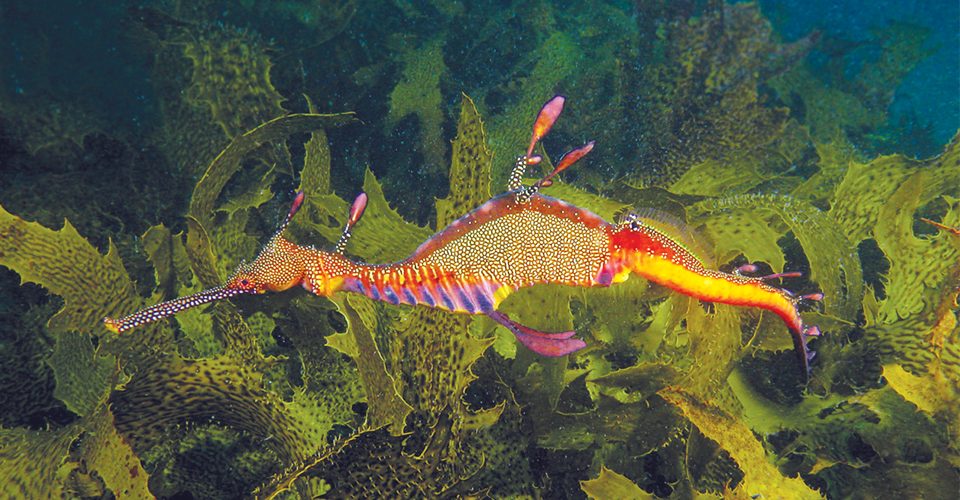FOR CENTURIES, seahorses have held our curiosity. They appear in scrolls from ancient Greece and seaside tales from the Victorian era. The seahorse form even appears in the folds of our brains, in the shape of the hippocampus – the component of our limbic system responsible for consolidating memories and for spatial navigation.
FOR CENTURIES, seahorses have held our curiosity. They appear in scrolls from ancient Greece and seaside tales from the Victorian era. The seahorse form even appears in the folds of our brains, in the shape of the hippocampus – the component of our limbic system responsible for consolidating memories and for spatial navigation.
However, the popular image of this peculiar creature dancing- in swaying sea grass and mangrove forests might not be in tune with reality. Overfishing and disruption to coastal seas, where the majority- of seahorses live, are threatening their populations. According to the World Conservation Union, nine of the planet’s 33 seahorse species are listed as vulnerable and one is endangered. Meanwhile, 25 million seahorses are traded annually, primarily for use in traditional Chinese medicine as a cure for a variety of ailments-, including impotence, poor blood circulation and wheezing.
The epicenter of the rallying cry for more protection is Project Seahorse, a BC-based organization run by two of the world’s most prolific seahorse researchers, Canadian marine biologist and conservationist Amanda Vincent and her British counterpart Heather Koldewey. Obviously they’re not the first to tackle marine conservation and target awareness about the impacts of overfishing on our oceans, but they certainly are the first to pick the highly charismatic seahorse as their protagonist.
“Ultimately, seahorses are flagship species for a wide range of marine conservation issues,” says Vincent. “Their dwindling numbers- suggest larger problems, including the depletion of other fish species and destruction of vital marine habitats, such as coral reefs and sea grasses. Saving seahorses means saving their threatened- marine ecosystems, and in turn, improving food security for the human communities that depend on them for survival.”
Overfishing and unsustainable practices – like those that resulted in the collapse of Newfoundland’s cod industry – illustrate the intrinsic link between human enterprise and nature. The Project Seahorse team’s diverse fields of expertise show a healthy bias towards continuing to drive home that link.
One research associate, Sarah Foster, focuses on bycatch (unintentionally caught fish) and trade of seahorses. Two others, Phil Molloy and Mai Yasue, have worked tirelessly to examine the connection between human actions, conservation efforts and delicate ecosystems. Vincent says they wholeheartedly believe that solutions will be found if both the public and policy makers appreciate this symbiosis.
“In our view, a hierarchy of concentric pressures bears down on individual animals, creating ‘an onion world’ effect,” says Vincent, noting that each layer effects the other. “By working to protect seahorses, Project Seahorse supports marine conservation more broadly.”
The project’s origins trace back to Vincent’s PhD research at Cambridge University in the 1980s. “At the time, most of what was known about syngnathids [the family of fuse-jawed fish that seahorses belong to] was decades old,” she says. “I was one of the first scientists to document seahorses’ unusual mating habits.”
Their bizarre behaviour intrigued Vincent. A three-day courtship is followed by the female depositing her eggs in the male’s pouch, where he nourishes and fertilizes them, ultimately giving birth two to four weeks later through contractions. During the gestation period, the female visits the male for daily “morning greetings,” five- to ten-minute interactions where they may link tails and change colours. What compelled Vincent even more was that despite the male’s specialized parental function, he still retained the conventional sex role of greater competitiveness, manifesting as male-to-male competition for access to mates. (Many seahorse pairs are monogamous and remain together during the entire breeding season.)
Vincent was hooked. She continued to study seahorses at Cambridge’s zoology department and in the wild. “Through my work, I discovered the trade in seahorses was much larger than previously suspected,” she says. “By the early 1990s, it was clear that many species were facing extreme pressure from overexploitation, pressure that was also damaging entire marine ecosystems.”
It was then that Vincent connected with the like-minded Koldewey, who was researching seahorse genetics at the Zoological Society of London (where she would later become the program manager for international marine and freshwater conservation). In 1996, the duo launched Project Seahorse at McGill University in Montreal. “We established an international team of researchers and community development specialists dedicated to finding ways to reduce those pressures, protect seahorse populations and ensure sustainable livelihoods for those who depend on seahorse fishing,” says Vincent.
The team wasted no time, turning their focus towards the community of Handumon in the Philippines, where seahorse fishing plays a vital role in the local economy. Vincent and her team helped to establish a community-managed marine sanctuary there, promoting traditional fishing techniques and “no-take” areas, as well as encouraging a unified organization of small scale fishers.
The project quickly spread to other countries, attracting scientists and other interested professionals. By late 2002, Project Seahorse had grown to include nearly 40 researchers, community development specialists and support staff, with project alumni working on every continent.
The team uprooted and moved headquarters from McGill to the Fisheries Centre at the University of British Columbia in Vancouver in late 2002. There are no known seahorse species native to Canada (although the Hippocampus erectus, or lined seahorse, occasionally drifts north from the Gulf of Mexico’s warmer waters) so the project focuses on conservation efforts abroad. Post-graduate students have conducted field research in Portugal, Central America, Sri Lanka and Vietnam under Project Seahorse’s guidance. The Philippines is still the project’s largest contingent, with about 16 full-time students, scientists, researchers and community development specialists.
Although the organization has garnered many awards and partnerships, Vincent says one of their proudest moments was helping to generate a landmark global agreement in 2002 under the Convention on the International Trade in Endangered Species (CITES), forbidding countries to export more seahorses than wild populations could bear. Only Indonesia, Japan, Norway and South Korea chose to opt out of the trade rules.
“This, the first-ever global agreement on trade in marine fishes of commercial importance, created a new international tool for fisheries management,” says Vincent, who serves as lead scientific advisor and chair of the seahorse working group at CITES, and is the Canada Research Chair in Marine Conservation. “[CITES] also effectively acknowledged that marine fish are wildlife as well as economic commodities.”
While mutually agreeable conservation efforts are certainly being built, Vincent says the implementation of the convention still presents challenges, “largely because countries don’t know how to proceed” while following trade rules and keeping their economy thriving.
Nonetheless, Vincent hopes the seahorse can be a game changer. “We will continue to work tirelessly to make the trade in seahorses sustainable, and we have a number of other seahorse- and marine-conservation focused projects underway.”
Shouldn’t the curious little creature that has held our attention for centuries be an apt metaphor for our oceans’ health? Vincent and Koldewey may be on to something.
Andrew Seale is a freelance journalist and seahorse enthusiast with an interest in water sustainability issues. His writing has appeared in The Toronto Star, Vancouver Sun, The Calgary Herald and other publications.













